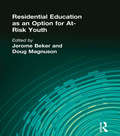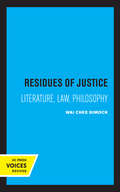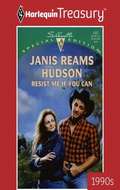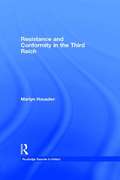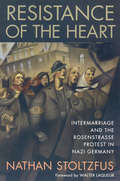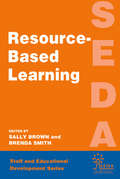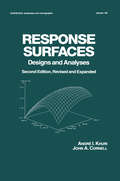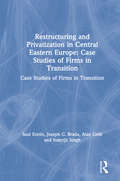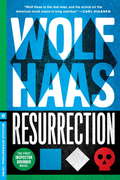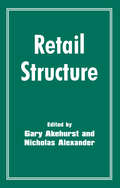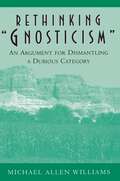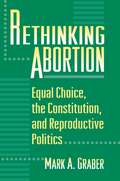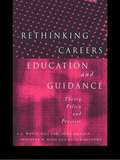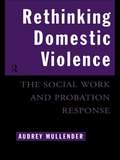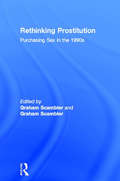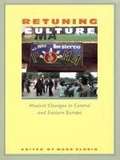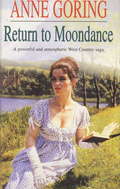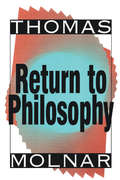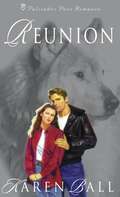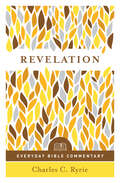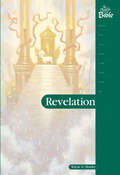- Table View
- List View
Residential Education as an Option for At-Risk Youth
by Jerome Beker Doug MagnusonResidential Education as an Option for At-Risk Youth explores recent residential programs in Israel, draws comparisons with their European counterparts, and recommends practical approaches for the revitalization of such programs in the United States. This volume refutes the conventional professional “wisdom” in the United States that residential group care programs for children and youth are intrinsically flawed and counterproductive. Instead, it delivers effective models for the implementation of effective residential services. The editors and authors demonstrate the growing need for residential programs, given the overburdened family foster care resources, swelling numbers of “zero-parent” families, and homeless youth. Though the United States helped launch and develop residential services in Europe in the aftermath of World War II and has produced many excellent thinkers in the domain of quality residential group care, American programs have languished in recent decades. This book is designed to accelerate and facilitate progress in revamping and establishing excellent residential group care. The authors examine residential education as a developmentally based alternative to the more clinically and correctionally oriented programs for marginal children and youth dominating this field in the United States.The authors present their material in the context of appropriate theoretical principles, yet in practical ways that will permit program developers and managers to implement it effectively. Some of the specific areas chapters discuss are: exemplary Israeli programs as observed by visiting American professional in social work and allied fields important program variables and the cultural influences that may affect them African American experience for such programs a conceptual model for building successful residential education programs key organizational and management considerationsResidential Education as an Option for At-Risk Youth serves as a vital resource for ambitious program developers and managers wishing to reconceptualize and enrich their programs. It will also benefit advanced students, practitioners, and decision makers who have had, heretofore, few resources to rely on when seeking to promote more effective programs for socially marginal children and youth.
Residues of Justice: Literature, Law, Philosophy
by Wai Chee DimockThis title is part of UC Press's Voices Revived program, which commemorates University of California Press’s mission to seek out and cultivate the brightest minds and give them voice, reach, and impact. Drawing on a backlist dating to 1893, Voices Revived makes high-quality, peer-reviewed scholarship accessible once again using print-on-demand technology. This title was originally published in 1996.
Resist Me If You Can
by Janis Reams HudsonRESIST ME IF YOU CAN Kat Comstock was quite an eyeful...just perfect for dating! But while Sheriff J. D. Ryan was certain the new schoolteacher would fall at his feet-just like every other single gal in town-he had a sneaking suspicion that she would play for keeps...and J.D. intended to stay single. Kat wanted to start a new life, not get involved with a man who thought he was the greatest thing since sliced bread! And she wasn't about to succumb to J.D.'s considerable charm. No, this lawman needed a lesson in humility...and she was just the woman to teach it!
Resistance and Conformity in the Third Reich (Routledge Sources in History)
by Martyn HousdenThis is a thematically arranged text illustrating popular resisitance to Nazism in Germany from 1930-1945, and the affect of Nazism on everyday life. The book combines a lucid, synthesized analysis together with a wide selection of integrated source material taken from pamphlets, diaries, recent oral testimonies, correspondence and more. Different chapters focus on social groups and activities, such as youth movements, religion, Jewish Germans, and the working classes.
Resistance of the Heart
by Nathan StoltzfusIn February 1943 the Gestapo arrested approximately 10,000 Jews remaining in Berlin. Most died at Auschwitz. Two thousand of those Jews, however, had non-Jewish partners and were locked into a collection center on a street called Rosenstrasse. As news of the surprise arrest pulsed through the city, hundreds of Gentile spouses, mostly women, hurried to the Rosenstrasse in protest. A chant broke out: "Give us our husbands back."Over the course of a week protesters vied with the Gestapo for control of the street. Now and again armed SS guards sent the women scrambling for cover with threats that they would shoot. After a week the Gestapo released these Jews, almost all of whom survived the war.The Rosenstrasse Protest was the triumphant climax of ten years of resistance by intermarried couples to Nazi efforts to destroy their families. In fact, ninety-eight percent of German Jews who did not go into hiding and who survived Nazism lived in mixed marriages. Why did Hitler give in to the protesters? Using interviews with survivors and thousands of Nazi records never before examined in detail, Nathan Stoltzfus identifies the power of a special type of resistance--the determination to risk one's own life for the life of loved ones. A "resistance of the heart..."
Resource Based Learning (SEDA Series)
by Brenda Smith Sally BrownResource-based learning has emerged as a response to the changing expectations of students. This text provides strategies for its implementation, development evaluation and discusses the implications for resource centres.
Resources for Teaching Elementary School Science
by National Science Resources Center Staff National Academy of Sciences Staff Smithsonian Institution StaffWhat activities might a teacher use to help children explore the life cycle of butterflies? What does a science teacher need to conduct a "leaf safari" for students? Where can children safely enjoy hands-on experience with life in an estuary? Selecting resources to teach elementary school science can be confusing and difficult, but few decisions have greater impact on the effectiveness of science teaching.Educators will find a wealth of information and expert guidance to meet this need in Resources for Teaching Elementary School Science. A completely revised edition of the best-selling resource guide Science for Children: Resources for Teachers, this new book is an annotated guide to hands-on, inquiry-centered curriculum materials and sources of help in teaching science from kindergarten through sixth grade. (Companion volumes for middle and high school are planned.)The guide annotates about 350 curriculum packages, describing the activities involved and what students learn. Each annotation lists recommended grade levels, accompanying materials and kits or suggested equipment, and ordering information.These 400 entries were reviewed by both educators and scientists to ensure that they are accurate and current and offer students the opportunity to: Ask questions and find their own answers. Experiment productively. Develop patience, persistence, and confidence in their own ability to solve real problems. The entries in the curriculum section are grouped by scientific area--Life Science, Earth Science, Physical Science, and Multidisciplinary and Applied Science--and by type--core materials, supplementary materials, and science activity books. Additionally, a section of references for teachers provides annotated listings of books about science and teaching, directories and guides to science trade books, and magazines that will help teachers enhance their students' science education.Resources for Teaching Elementary School Science also lists by region and state about 600 science centers, museums, and zoos where teachers can take students for interactive science experiences. Annotations highlight almost 300 facilities that make significant efforts to help teachers.Another section describes more than 100 organizations from which teachers can obtain more resources. And a section on publishers and suppliers give names and addresses of sources for materials.The guide will be invaluable to teachers, principals, administrators, teacher trainers, science curriculum specialists, and advocates of hands-on science teaching, and it will be of interest to parent-teacher organizations and parents.
Responding to Market Failures
by J. Gregory DeesBroadly defines the concept of market failure and explores options for responding to it. It pays particular attention to the role of business leaders in addressing market deficiencies.
Response Surfaces: Second Edition (Statistics: A Series Of Textbooks And Monographs #152)
by Andre I. Khuri John A. CornellResponse Surfaces: Designs and Analyses; Second Edition presents techniques for designing experiments that yield adequate and reliable measurements of one or several responses of interest, fitting and testing the suitability of empirical models used for acquiring information from the experiments, and for utilizing the experimental results to make decisions concerning the system under investigation. This edition contains chapters on response surface models with block effects and on Taguchi's robust parameter design, additional details on transformation of response variable, more material on modified ridge analysis, and new design criteria, including rotatability for multiresponse experiments. It also presents an innovative technique for displaying correlation among several response. Numerical examples throughout the book plus exercises--with worked solutions to selected problems--complement the text.
Restructuring and Privatization in Central Eastern Europe: Case Studies of Firms in Transition
by Alan Gelb Inderjit Singh Joseph C. Brada Saul EstrinThis volume presents cases from a World Bank study of state-owned industrial firms in Poland, Hungary and the Czech and Slovak republics. Topics that are covered include: structure of the industry; history of the firm; and product mix and sales pattern.
Resurrection
by Annie Janusch Wolf HaasWhen the corpses of an American couple are found frozen to death on a ski lift in a pristine Alpine village, Brenner is called in to investigate, in his first case as a P.I.When Inspector Simon Brenner leaves the police force, he's looking forward to some peace and quiet, and the lovely Alpine village of Zell seems like just the place. That is, until the corpses of an American couple are found frozen on a ski lift, and Brenner, doing some part time work for an insurance company, is called in to investigate the matter. It turns out that the victims have relatives in the area, and the crime--if it is a crime--seems like it could be a family affair. Except the prime suspect has a solid alibi and no one in picture-perfect Zell is talking.So Brenner, in his inimitable style, draws out all the village's characters--the longtime residents, the resort staff and guests--and uncovers the dirty doings that lurk underneath the pristine snow...and family secrets long buried. This first book sets up the totally unique, quirky narrative voice that runs throughout the series and introduces the reluctant, yet brilliant, Detective Brenner,in a plot with as many twists and turns as a Double Black Diamond.
Retail Structure
by Nicholas Alexander Gary AkehurstFirst Published in 1996. Routledge is an imprint of Taylor & Francis, an informa company.
Rethinking "Gnosticism": An Argument for Dismantling a Dubious Category
by Michael Allen WilliamsMost anyone interested in such topics as creation mythology, Jungian theory, or the idea of "secret teachings" in ancient Judaism and Christianity has found "gnosticism" compelling. Yet the term "gnosticism," which often connotes a single rebellious movement against the prevailing religions of late antiquity, gives the false impression of a monolithic religious phenomenon. Here Michael Williams challenges the validity of the widely invoked category of ancient "gnosticism" and the ways it has been described. Presenting such famous writings and movements as the Apocryphon of John and Valentinian Christianity, Williams uncovers the similarities and differences among some major traditions widely categorized as gnostic. He provides an eloquent, systematic argument for a more accurate way to discuss these interpretive approaches. The modern construct "gnosticism" is not justified by any ancient self-definition, and many of the most commonly cited religious features that supposedly define gnosticism phenomenologically turn out to be questionable. Exploring the sample sets of "gnostic" teachings, Williams refutes generalizations concerning asceticism and libertinism, attitudes toward the body and the created world, and alleged features of protest, parasitism, and elitism. He sketches a fresh model for understanding ancient innovations on more "mainstream" Judaism and Christianity, a model that is informed by modern research on dynamics in new religious movements and is freed from the false stereotypes from which the category "gnosticism" has been constructed.
Rethinking Abortion: Equal Choice, the Constitution, and Reproductive Politics
by Mark GraberMark Graber looks at the history of abortion law in action to argue that the only defensible, constitutional approach to the issue is to afford all women equal choice--abortion should remain legal or bans should be strictly enforced. Steering away from metaphysical critiques of privacy, Graber compares the philosophical, constitutional, and democratic merits of the two systems of abortion regulation witnessed in the twentieth century: pre-Roe v. Wade statutory prohibitions on abortion and Roe's ban on significant state interference with the market for safe abortion services. He demonstrates that before Roe, pro-life measures were selectively and erratically administered, thereby subverting our constitutional commitment to equal justice. Claiming that these measures would be similarly administered if reinstated, the author seeks to increase support for keeping abortion legal, even among those who have reservations about its morality. Abortion should remain legal, Graber argues, because statutory bans on abortion have a history of being enforced in ways that intentionally discriminate against poor persons and persons of color. In the years before Roe, the same law enforcement officials who routinely ignored and sometimes assisted those physicians seeking to terminate pregnancies for their private patients too often prevented competent abortionists from offering the same services to the general public. This double standard violated the fundamental human and constitutional right of equal justice under law, a right that remains a major concern of the equal protection clause of the Fourteenth Amendment.
Rethinking Careers Education and Guidance: Theory, Policy and Practice
by Jennifer M. Kidd A. G. Watts Ruth Hawthorn John Killeen Bill LawRe-thinking Careers Education and Guidance is the first book published in the United Kingdom to cover theory, policy and practice in all sectors of careers education and guidance provision. The book features: * an authoritative review of career theories, together with a new career learning theory * an analysis of the development of careers provision in schools; colleges; higher education; work organisations; the Careers Service, and in other agencies * an examination of the main aspects of practice * an exploration of ways of supporting development and evaluation * an analysis of the role of public policy, and the development of guidance systems in other parts of the world. Re-thinking Careers Education and Guidance is an essential text for students in initial training, those engaged in in-service and higher degree work, and reflective guidance practitioners.
Rethinking Domestic Violence: The Social Work and Probation Response
by Audrey MullenderFirst published in 1996. Routledge is an imprint of Taylor & Francis, an informa company.
Rethinking Prostitution: Purchasing Sex in the 1990s
by Graham Scambler Annette ScamblerThe growth of AIDS has focused renewed attention on the institution of prostitution. In contrast to the moral panic reaction of some sectors of society, very different initiatives are being displayed by other groups in relation to the need to scrutinize the social, moral and legal status of prostitution and to reflect on the arguments in support of and against legalising brothels, paying particular concern to prostitutes' own health. Rethinking Prostitution covers male as well as female sex workers and considers in detail their status in law; drugs; issues of health and health care; the changing nature of sex work; partners, boyfriends and pimps; and the potential for redefining prostitution. By drawing on the expertise of researchers across all aspects of the industry, this up-to-date text focuses on an institution and industry ripe for re-assessment. Rethinking Prostitution will be of considerable interest to students, lecturers and researchers in medical sociology and women's studies as well as to social workers in training and practice.
Retuning Culture: Musical Changes in Central and Eastern Europe
by Mark SlobinAs a measure of individual and collective identity, music offers both striking metaphors and tangible data for understanding societies in transition--and nowhere is this clearer than in the recent case of the Eastern Bloc. Retuning Culture presents an extraordinary picture of this phenomenon. This pioneering set of studies traces the tumultuous and momentous shifts in the music cultures of Central and Eastern Europe from the first harbingers of change in the 1970s through the revolutionary period of 1989-90 to more recent developments.During the period of state socialism, both the reinterpretation of the folk music heritage and the domestication of Western forms of music offered ways to resist and redefine imposed identities. With the removal of state control and support, music was free to channel and to shape emerging forms of cultural identity. Stressing both continuity and disjuncture in a period of enormous social and cultural change, this volume focuses on the importance and evolution of traditional and popular musics in peasant communities and urban environments in Hungary, Poland, Romania, Russia, the Czech Republic, Ukraine, the former Yugoslavia, Macedonia, and Bulgaria. Written by longtime specialists in the region and considering both religious and secular trends, these essays examine music as a means of expressing diverse aesthetics and ideologies, participating in the formation of national identities, and strengthening ethnic affiliation.Retuning Culture provides a rich understanding of music's role at a particular cultural and historical moment. Its broad range of perspectives will attract readers with interests in cultural studies, music, and Central and Eastern Europe.Contributors. Michael Beckerman, Donna Buchanan, Anna Czekanowska, Judit Frigyesi, Barbara Rose Lange, Mirjana Lausevic, Theodore Levin, Margarita Mazo, Steluta Popa, Ljerka Vidic Rasmussen, Timothy Rice, Carol Silverman, Catherine Wanner
Return to Moondance
by Anne GoringMiranda Brehault's free and happy childhood at Moondance, a crumbling old house on the edge of Dartmoor, comes to an abrupt end when she is left orphaned and penniless at the age of ten. Moondance's new owner, Theophilus Crowe, promises to take care of her, but instead he dispatches her to a cotton mill in Derbyshire.Conditions at Crossbank Mill are harsh and pitiless; Miranda and the other pauper children are little more than prisoners. Desperate to escape, Miranda and her friend Biddie run away, helped by the mill master's young wife Caroline and by Caroline's rebellious cousin, Kit Warrener, who escorts the girls to Furze House on the south coast of Devon. As she grows to womanhood there amongst new friends, Miranda dreams of returning to Moondance, and of taking revenge on the man who ruined her childhood. Her growing attraction to Kit, who has become caught up in the smuggling trade, cannot distract her from her true goal. But will she choose revenge and Moondance over true love?
Return to Moondance
by Anne GoringMiranda Brehault's free and happy childhood at Moondance, a crumbling old house on the edge of Dartmoor, comes to an abrupt end when she is left orphaned and penniless at the age of ten. Moondance's new owner, Theophilus Crowe, promises to take care of her, but instead he dispatches her to a cotton mill in Derbyshire.Conditions at Crossbank Mill are harsh and pitiless; Miranda and the other pauper children are little more than prisoners. Desperate to escape, Miranda and her friend Biddie run away, helped by the mill master's young wife Caroline and by Caroline's rebellious cousin, Kit Warrener, who escorts the girls to Furze House on the south coast of Devon. As she grows to womanhood there amongst new friends, Miranda dreams of returning to Moondance, and of taking revenge on the man who ruined her childhood. Her growing attraction to Kit, who has become caught up in the smuggling trade, cannot distract her from her true goal. But will she choose revenge and Moondance over true love?
Return to Philosophy
by Thomas MolnarFrom its earliest beginnings and through much of its history, the philosophical enterprise has rooted its intellectual procedures in common sense. Ordinary discourse is what the pre-Socratic thinkers did at the dawn of speculation. The same approach was characteristic of the medieval mystics, Pascal in the seventeenth century, and Gaston Bachelard in the twentieth century. However with the ascendency of the physical sciences, mathematics, and depth psychology as influences in contemporary thought, philosophical language and forms of expression became increasingly distant from ordinary language. This created estrangement and confusion in the learner's mind. In Return to Philosophy Thomas Molnar diagnoses the verbal derailment of philosophy and shows how it might be reconnected to the realities of human life.While granting that philosophy must use a somewhat specialized language, Molnar attacks jargon-laden thought by tracing certain root assumptions that go deeper than the issue of language itself. He locates these assumptions in the work of philosophers who, espousing modernity, no longer trust the "reality of the real," and are convinced that the world and our perception of it are elusive, offering no foundation except in the human mind which, however, is also the result of a "social contract," a temporary consensus or transient network of meanings readily discardable. According to changing ideologies and social structures we use "signs" linguistic, psychological, hermeneutical, structuralist, existentialist not to express reality but to establish communication with others. Philosophy, then, shifts from the task of knowing reality to the task of communicating here and now.Return to Philosophy is a unique endeavor. Molnar's book unmasks the modern derailment and shows that many leading philosophers do not so much philosophize, but merely elaborate verbal-technical instruments in what may be little more than trivial language games. This volume will be of interest to philosophers, cultural historians, and sociologists.
Reunion
by Karen BallThis rerelease of the first Palisades romance by Karen Ball tells the story of a young widow who learns to love again. Taylor Sorensen has a secret: there are wolves on her ranch. Taylor's new ranch hand, Connor Alexander, has a secret, too: he's a wildlife biologist who's been sent to find out if, after sixty years, wolves have returned to Wyoming. Caught in a fierce battle against angry ranchers and centuries of superstition, Taylor and Connor are drawn together by their desire to protect these wild, majestic animals. What they don't know is that there's someone else out there who hates the wolves -- someone who's as determined to get rid of them as Taylor and Connor are to protect them.From the Trade Paperback edition.
Revelation (Everyday Bible Commentary)
by Charles C. RyrieRevelation is a wild book. It&’s full of strange hybrid animals with extra wings, horns, and eyes. It contains both descriptions of historical events and prophecies about the future. And it can be difficult to know which parts are figurative and which parts are literal. What we need is a guide—someone who will tell us what&’s historical and what&’s prophetic, and explain all the strange symbolism clearly and simply. This is what the best preachers do, but you don&’t have to wait until Sunday&’s sermon. Encounter the beautiful depth of Revelation through an enlightening verse-by-verse commentary from Charles Ryrie that&’s both straightforward and insightful. You&’ll gain:Important historical background Insights from the original languageExplanations of the prophetic symbols And more!You don&’t have to go to seminary to encounter God in exciting, new ways through His Word. Discover how much more enjoyable your personal study will be with understandable, quality Bible commentary for everyday life.
Revelation (Everyday Bible Commentary)
by Charles C. RyrieRevelation is a wild book. It&’s full of strange hybrid animals with extra wings, horns, and eyes. It contains both descriptions of historical events and prophecies about the future. And it can be difficult to know which parts are figurative and which parts are literal. What we need is a guide—someone who will tell us what&’s historical and what&’s prophetic, and explain all the strange symbolism clearly and simply. This is what the best preachers do, but you don&’t have to wait until Sunday&’s sermon. Encounter the beautiful depth of Revelation through an enlightening verse-by-verse commentary from Charles Ryrie that&’s both straightforward and insightful. You&’ll gain:Important historical background Insights from the original languageExplanations of the prophetic symbols And more!You don&’t have to go to seminary to encounter God in exciting, new ways through His Word. Discover how much more enjoyable your personal study will be with understandable, quality Bible commentary for everyday life.
Revelation (The People's Bible)
by Wayne D MuellerWhat is the book of Revelation about in the Bible? Who wrote Revelation?The last book of the Bible, Revelation, provides Christians with a beautiful assurance of Christ’s final victory. The seven visions the apostle John records in Revelation describe the ongoing struggle between Christ and Satan. In this book, God assures believers that they will have eternal victory in the new Jerusalem above and that Satan finally will be defeated—just as God promised.Want to learn more? If you’re wondering what the book of Revelation is all about, this helpful resource is for you!Revelation is a reliable Bible commentary. It’s down to earth, clearly written, easy to read and understand, and filled with practical and modern applications to Scripture.It also includes the complete text of the book of Revelation from the NIV Bible. The Christ-centered commentaries following the Scripture sections contain explanations of the text, historical background, illustrations, and archaeological information. Revelation is a great resource for personal or group study!This book is a part of The People’s Bible series from Northwestern Publishing House.
